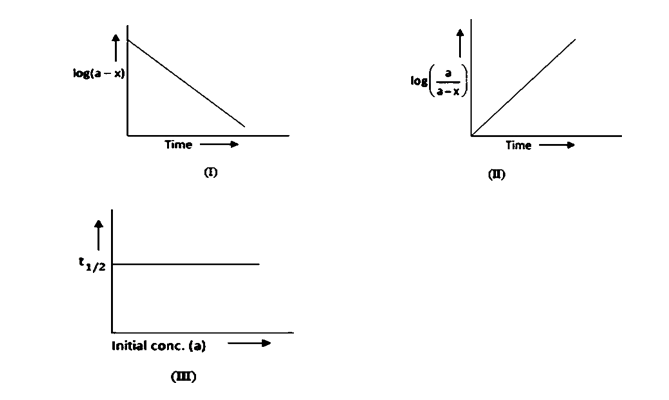Half life of a first order reaction is 4s and the initial concentration of the reactant is 0.12 M. The concentration of the reactant left after 16 s is
0.0075 M
0.06M
0.03 M
0.015M
The correct Answer is:A
To find the concentration of the reactant left after 16 seconds for a first-order reaction, we can follow these steps:
Step 1: Determine the rate constant (k)
The half-life (T_half) of a first-order reaction is given by the formula:
T1/2=0.693k
Given that T1/2=4s, we can rearrange the formula to find k:
k=0.693T1/2=0.6934
Step 2: Calculate the value of k
Calculating k:
k=0.6934=0.17325s−1
Step 3: Use the first-order reaction formula
The concentration of the reactant at time t (A_t) can be calculated using the formula:
At=A0⋅e−kt
Where:
- A0 is the initial concentration (0.12 M)
- t is the time (16 s)
- k is the rate constant we just calculated
Step 4: Substitute the values into the formula
Substituting the values:
At=0.12⋅e−0.17325⋅16
Step 5: Calculate the exponent
Calculating the exponent:
−kt=−0.17325⋅16=−2.772
Step 6: Calculate e−2.772
Now we calculate:
e−2.772≈0.062
Step 7: Calculate the concentration after 16 seconds
Finally, substituting back into the equation:
At=0.12⋅0.062
At≈0.00744M
Conclusion
The concentration of the reactant left after 16 seconds is approximately:
At≈0.00744M
---
The half-life (T_half) of a first-order reaction is given by the formula:
T1/2=0.693k
Given that T1/2=4s, we can rearrange the formula to find k:
k=0.693T1/2=0.6934
Calculating k:
k=0.6934=0.17325s−1
The concentration of the reactant at time t (A_t) can be calculated using the formula:
At=A0⋅e−kt
Where:
- A0 is the initial concentration (0.12 M)
- t is the time (16 s)
- k is the rate constant we just calculated
Substituting the values:
At=0.12⋅e−0.17325⋅16
Calculating the exponent:
−kt=−0.17325⋅16=−2.772
Now we calculate:
e−2.772≈0.062
Finally, substituting back into the equation:
At=0.12⋅0.062
At≈0.00744M
The concentration of the reactant left after 16 seconds is approximately:
At≈0.00744M
Topper's Solved these Questions
- BOOK - DISHA PUBLICATIONCHAPTER - CHEMICAL KINETICS EXERCISE - EXERCISE 1 : CONCEPT BUILDER (TOPICWISE)(TOPIC 3 : Theories of Rate of Reaction)17videos
CHEMICAL KINETICS
- BOOK - DISHA PUBLICATIONCHAPTER - CHEMICAL KINETICS EXERCISE - EXERCISE 2 : CONCEPT APPLICATOR30videos
CHEMICAL KINETICS
- BOOK - DISHA PUBLICATIONCHAPTER - CHEMICAL KINETICS EXERCISE - EXERCISE 1 : CONCEPT BUILDER (TOPICWISE) (TOPIC 1: Rate of Reaction, Rate Laws and Rate Constant)11videos
CHEMICAL KINETICS
- BOOK - DISHA PUBLICATIONCHAPTER - CHEMICAL BONDING AND MOLECULAR STRUCTURE EXERCISE - EXERCISE-2: CONCEPT APPLICATOR30videos
CHEMICAL BONDING AND MOLECULAR STRUCTURE
- BOOK - DISHA PUBLICATIONCHAPTER - CHEMISTRY IN EVERDAY LIFE EXERCISE - Exercise88videos
CHEMISTRY IN EVERDAY LIFE
Similar Questions
Which of the following is/are correct for the first order reaction ? (a is initial concentration of reactant, x is concentration of the reactant reacted and t is time)
 View Solution
View SolutionThe half-life of a reaction is halved as the initial concentration of the reaction is doubled. The order of the reaction is
View Solution
Knowledge Check
- Question 1 - Select One
The half-life of a first order reaction is 30 min and the initial concentration of the reactant is 0.1 M. If the initial concentration of reactant is doubled, then the half-life of the reaction will be
A1800 sB60 minC15 minD900 s - Question 2 - Select One
The half life of a first order reaction is 30 min and the initial concentration of the reactant is 0.1 M . If the initial concentration of reactant is doubled ,then the half life of the reaction will be
A1800SB60 minC15 minD900s - Question 3 - Select One
In a first order reaction with time the concentration of the reactant decreases
AlinearlyBexponentiallyCno changeDNone of these
For a first order reaction, if ‘a’ is the initial concentration of reactant, then the half life time is
View SolutionIn a first order reaction A→B, if k is rate constant and initial concentration o f the reactant A is 0.5 M then the half-life is
View SolutionIn a first order reaction A→B, if k is rate constant and initial concentration o f the reactant A is 0.5 M then the half-life is
View SolutionIn a first order reaction A → B, if k is rate constant and initial concentration of the reactant A is 2 M then the half life of the reaction is:
View SolutionThe half life period of a reaction is halved as the initial concentration of the reactants is doubled. The order of reaction is:
View Solution

